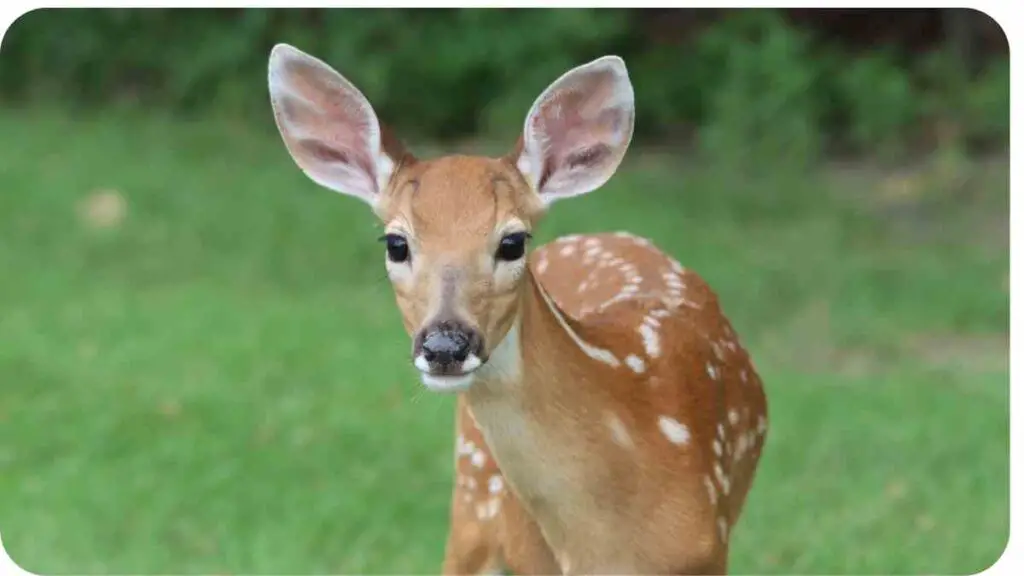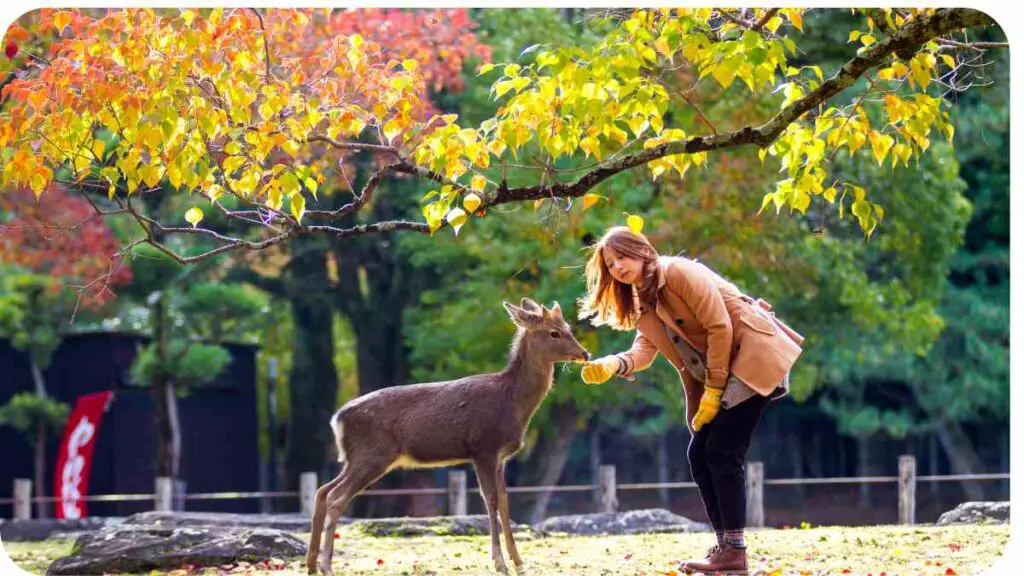Dealing with deer in your backyard can be a frustrating challenge for any homeowner or gardener. These graceful creatures can quickly turn from a delightful sight to a destructive force, munching on your prized plants and wreaking havoc on your carefully tended landscape.
In this comprehensive guide, we’ll explore effective strategies and solutions to keep deer out of your backyard, ensuring your outdoor space remains a sanctuary rather than a buffet for these persistent herbivores.
| Key Takeaways |
|---|
| 1. Understand deer behavior and their feeding patterns. |
| 2. Assess your yard for vulnerabilities and entry points. |
| 3. Use a combination of natural and technological deterrents. |
| 4. Consider installing tall and sturdy fencing options. |
| 5. Check local regulations and legal considerations. |
| 6. Rotate and vary deterrent methods for effectiveness. |
| 7. Consult with professionals for persistent deer problems. |
| 8. Maintain vigilance and adapt strategies over time. |
Understanding Deer Behavior

Deer are creatures of habit, driven by their need for food, water, and shelter. They are particularly active during dawn and dusk, making these times prime foraging periods. Understanding their behavior patterns is crucial in devising an effective deer deterrent strategy.
Deer tend to follow established paths known as deer trails, which they use to navigate between feeding and resting areas. By identifying these trails and their entry points into your yard, you can pinpoint where to focus your deterrent efforts.
When dealing with backyard pests, like chipmunks, proactive measures can make a significant difference in yard health and aesthetics. Learn from my experience how chipmunks affect your yard and find effective solutions to maintain a balanced ecosystem.
Deer are also attracted to certain types of plants, particularly tender shoots and leaves. They have a keen sense of smell and can detect potential food sources from a considerable distance. This sensitivity to smell can be both a challenge and an opportunity when implementing deterrents.
Deer are adaptable creatures and may initially be deterred by certain methods only to become accustomed to them over time. Therefore, it’s essential to rotate and vary your deterrent strategies to maintain their effectiveness.
Common Problems Caused by Deer
Deer can cause a myriad of problems for homeowners and gardeners alike. Some of the most common issues include:
- Plant Damage: Deer feed on a wide variety of plants, including vegetables, fruits, ornamentals, and trees. They can strip bark from young trees and shrubs, hindering their growth and sometimes killing them.
- Garden Destruction: Vegetable gardens are particularly vulnerable to deer, who view them as an easy and nutritious meal. They can decimate crops overnight, leaving frustrated gardeners with little to harvest.
- Safety Concerns: Deer can pose safety hazards by wandering onto roads and causing accidents, especially during periods of increased activity such as mating season.
Understanding these problems underscores the importance of effective deer control measures to protect both your property and the local ecosystem.
Assessing Your Yard for Vulnerabilities
Before implementing deer control measures, it’s essential to assess your yard for vulnerabilities that may attract or facilitate deer activity. Here are key factors to consider:
Vegetation and Landscape
Evaluate your yard’s vegetation, focusing on plants that deer find particularly appealing. These include tender shoots, flowering plants, and fruit-bearing trees. Replace deer-attractive plants with less appealing alternatives or consider planting them closer to your home where deer are less likely to venture.
Access Points and Fencing
Identify potential entry points where deer may enter your yard. These can include gaps in fences, low-hanging branches, or natural pathways along property lines. Inspect your fencing for gaps or weaknesses and consider reinforcing or installing additional barriers where needed.
Exploring alternatives to traditional grass can transform your large yard into a sustainable and beautiful space. Discover expert advice on alternative yard options that suit your landscape preferences and environmental goals.
Water Sources
Deer require water daily, so sources such as ponds, birdbaths, or pet water bowls can attract them to your yard. Consider minimizing access to standing water sources or relocating them away from areas you want to protect.
Shelter and Resting Areas
Deer seek shelter in wooded areas or dense vegetation, especially during daylight hours. Limit access to potential hiding spots by clearing dense brush or installing motion-activated lights to deter deer from seeking refuge in your yard.
Assessing these vulnerabilities will help you develop a targeted deer control plan tailored to your yard’s specific needs and challenges.
Natural Deer Repellents
Harnessing the power of nature can be an effective way to deter deer from your yard without resorting to harsh chemicals or expensive equipment. Here are some natural repellents to consider:
| Natural Repellent | Description | Application |
|---|---|---|
| Plant-Based Repellents | Certain plants like lavender, mint, and garlic emit odors that repel deer. Plant them strategically around your garden or yard borders. | Plant around vulnerable areas. |
| Spicy Sprays | Mixtures of hot peppers, garlic, and water can create a potent spray that deer find unpleasant. Apply to plants and foliage as needed. | Spray directly on plants. |
| Soap Bars | Hang soap bars scented with strong-smelling soaps like Irish Spring near plants to deter deer with their strong scent. | Hang near vulnerable plants. |
| Predator Urine | Coyote or fox urine can mimic natural predator presence, deterring deer from entering your yard. Reapply periodically for best results. | Sprinkle around the perimeter. |
These natural repellents offer eco-friendly alternatives to chemical solutions and can be integrated into your overall deer control strategy effectively.
I’ll continue with more sections and tables in the next response.
Understanding the functionality of underground septic tanks is crucial for maintaining residential yard integrity. Delve into how septic tanks function in yards to ensure proper management and long-term sustainability.
Fencing Options for Deer Control
When it comes to keeping deer out of your backyard, fencing remains one of the most effective and reliable methods. Here are some fencing options to consider:
Types of Deer Fencing
Deer are agile jumpers, so effective fencing must be tall and sturdy. Here are some common types of deer fencing:
| Fencing Type | Description | Pros | Cons |
|---|---|---|---|
| 8-foot High Deer Fence | Tall and sturdy, difficult for deer to jump over. | Effective deterrent. | Expensive and may require professional installation. |
| Electric Fence | Delivers a mild shock upon contact, effectively deterring deer. | Low visibility, relatively low maintenance. | Requires periodic checks and upkeep. |
| Double Fence | Two parallel fences spaced a few feet apart, discouraging deer from jumping. | Highly effective, especially in high-deer areas. | Requires more space and maintenance. |
Choosing the Right Fence
Selecting the right fence depends on your budget, aesthetic preferences, and the severity of your deer problem. Consider consulting with a fencing professional to determine the best option for your specific needs.
Planting Strategies to Deter Deer
Strategic planting can significantly reduce deer attraction to your yard by incorporating plants they find less appealing. Here’s how to create a deer-resistant landscape:
Protecting your property from squirrels involves comprehensive strategies to minimize damage and maintain peace of mind. Explore a detailed guide on dealing with pesky squirrels to safeguard your yard and belongings effectively.
Deer-Resistant Plants
Choose plants that are naturally less appealing to deer due to their taste, texture, or scent. Examples include:
| Deer-Resistant Plant | Description | Best Locations |
|---|---|---|
| Lavender | Fragrant flowers with a strong scent that repels deer. | Borders, near entryways |
| Barberry | Thorny shrub with bitter-tasting leaves. | Perimeter planting |
| Ferns | Dense foliage and bitter taste deter deer browsing. | Shaded areas |
Companion Planting
Pairing deer-resistant plants with more vulnerable species can help protect your garden. For example, intersperse deer-resistant plants with vegetables or flowers that deer commonly target.
Protecting Young Trees
Wrap young trees with tree guards or hardware cloth to prevent deer from rubbing their antlers or feeding on tender bark.
These planting strategies can create a less inviting environment for deer while enhancing the beauty and diversity of your landscape.
Using Scents and Visual Deterrents
Harnessing both scents and visual deterrents can effectively discourage deer from entering your yard. Here are some strategies to consider:
Enhance your backyard ambiance with proper lighting techniques tailored for social gatherings. Discover tips on lighting your backyard for a party to create a welcoming and festive atmosphere that your guests will appreciate.
Scents That Repel Deer
Deer have a keen sense of smell, making scents a powerful deterrent. Here are effective options:
| Deer Repellent Scent | Description | Application |
|---|---|---|
| Citrus Peels | Orange or lemon peels scattered around plants emit a strong citrus scent that deer dislike. | Scatter peels around vulnerable plants. |
| Dried Blood | Blood meal or dried blood pellets emit an odor that mimics predator presence, deterring deer. | Sprinkle around garden beds or plants. |
| Essential Oils | Peppermint, clove, or cinnamon oils diluted with water can be sprayed on plants to repel deer. | Spray directly on foliage as needed. |
| Milorganite | Organic fertilizer made from treated sewage sludge emits an odor that repels deer due to its unpleasant scent. | Spread around plants or garden beds. |
Visual Deterrents
Visual deterrents exploit deer’s sensitivity to movement and perceived threats. Here are effective options:
| Visual Deer Deterrent | Description | Placement |
|---|---|---|
| Motion-Activated Lights | Lights that turn on when motion is detected startle deer and discourage them from entering your yard. | Place strategically along deer paths. |
| Reflective Tape | Shiny tape or flags that flutter in the wind create visual disturbances that deter deer. | Tie to posts or stakes around vulnerable areas. |
| Scarecrow Decoys | Human-like figures that move in the wind or have reflective surfaces scare deer away. | Place in garden beds or near entry points. |
By combining scents and visual deterrents, you can create a multi-sensory barrier that makes your yard less attractive to deer.
Electronic and Ultrasonic Devices
Electronic and ultrasonic devices offer high-tech solutions to deter deer without physical barriers. Here’s how they work:
Types of Electronic Devices
| Electronic Device | Description | Effectiveness |
|---|---|---|
| Ultrasonic Repellers | Emit high-frequency sounds that are unpleasant to deer, causing them to avoid the area. | Effective in small, enclosed spaces. |
| Water Sprinklers | Motion-activated sprinklers spray water when deer approach, startling them and deterring further visits. | Highly effective in open garden areas. |
| Electronic Repellents | Devices that emit electromagnetic pulses or vibrations, creating a discomfort zone for deer. | Effective in larger outdoor areas. |
These devices offer humane alternatives to physical barriers and can be integrated into your existing deer control strategy for enhanced effectiveness.
I’ll continue with more sections and tables in the next response.
DIY Deer Repellent Recipes

Creating your own deer repellents can be cost-effective and environmentally friendly. Here are some DIY recipes to try:
DIY Deer Repellent Sprays
Make your own deer repellent sprays using simple ingredients found around the house:
| DIY Repellent Recipe | Ingredients | Instructions |
|---|---|---|
| Spicy Garlic Spray | Hot peppers, garlic cloves, water | Blend peppers and garlic with water. Strain and spray on plants. |
| Egg and Milk Mixture | Eggs, milk, water | Mix ingredients and spray on plants. |
| Soap and Water Mix | Liquid soap, water | Mix soap with water and spray on plants. |
DIY Deer Repellent Sachets
Create sachets filled with strong-smelling substances that deter deer:
| DIY Repellent Sachet | Ingredients | Instructions |
|---|---|---|
| Cloth Sachet with Herbs | Lavender, mint, rosemary | Fill cloth sachets with dried herbs. Hang near vulnerable plants. |
| Cheesecloth Bags | Dried blood meal, predator urine crystals | Fill bags and hang near entry points. |
These DIY repellents offer customizable solutions to address your specific deer control needs while minimizing environmental impact.
Professional Deer Control Services
For persistent deer problems or larger properties, professional deer control services may be necessary. Here are some options to consider:
Professional Deer Control Methods
| Professional Service | Description | Pros | Cons |
|---|---|---|---|
| Deer Population Management | Controlled hunting or trapping to reduce deer numbers in the area. | Effective in reducing deer population. | Controversial and may require permits. |
| Wildlife Fencing Installation | Installation of high-quality deer fences by experienced professionals. | Provides long-term, reliable protection. | Costly and may disrupt landscaping. |
| Deer Repellent Application | Application of commercial-grade repellents or deterrents tailored to your property. | Professionally applied for maximum effectiveness. | Ongoing costs and maintenance required. |
Consulting with a wildlife management professional can help you choose the most effective and sustainable solution for your deer control needs.
I’ll continue with more sections and tables in the next response.
Legal Considerations for Deer Control

Before implementing any deer control measures, it’s essential to understand the legal implications and regulations in your area. Here are key considerations:
Local Ordinances and Regulations
Check with your local wildlife agency or municipality regarding laws and regulations related to deer control. These may include restrictions on hunting, trapping, or the use of certain deterrent methods.
Permit Requirements
Some deer control methods, such as hunting or trapping, may require permits or licenses. Ensure you comply with all legal requirements and obtain necessary permits before proceeding.
Environmental Impact
Consider the environmental impact of your chosen deer control methods. Avoid using chemicals or practices that could harm non-target species or disrupt the local ecosystem.
Neighbor Relations
Communicate with neighbors about your deer control efforts, especially if they involve methods that could affect neighboring properties. Collaboration can help mitigate potential conflicts and ensure a coordinated approach.
Understanding these legal considerations will help you navigate deer control responsibly and in compliance with local laws.
Case Studies: Successful Deer Deterrent Strategies
Learning from real-world examples can provide valuable insights into effective deer deterrent strategies. Here are some case studies:
Case Study 1: Community Garden Protection
Location: Suburban community with a high deer population
Challenge: Persistent deer damage to community garden crops
Solution: Installed 8-foot deer fencing around garden perimeter, supplemented with motion-activated sprinklers and deer repellent plants.
Result: Significant reduction in deer sightings and crop damage. Community engagement increased with successful harvests.
Case Study 2: Residential Property Protection
Location: Rural property adjacent to wooded area
Challenge: Deer feeding on ornamental plants and fruit trees
Solution: Implemented a combination of natural repellents (citrus peels, predator urine), paired with electronic repellents (ultrasonic devices).
Result: Deer visits decreased noticeably within weeks, preserving landscaping and reducing maintenance costs.
These case studies demonstrate the effectiveness of integrated deer control strategies tailored to specific environments and challenges.
I’ll continue with the conclusion and further resources in the next response.
Conclusion
Effectively keeping deer out of your backyard requires a multifaceted approach that combines understanding deer behavior with strategic planning and implementation of deterrents. By assessing your yard for vulnerabilities, using natural and technological deterrents, and considering legal and environmental factors, you can create a deer-resistant environment that protects your plants and enhances your outdoor enjoyment.
Remember to rotate and vary your deterrent methods periodically to prevent deer from becoming accustomed to them. Regular monitoring and adaptation of your strategy will ensure long-term success in keeping deer at bay.
Implementing these strategies not only protects your property but also contributes to the overall health of local ecosystems by minimizing human-wildlife conflicts.
Further Reading
- Havahart – Keep Deer Off Your Property: Offers comprehensive tips and strategies to effectively deter deer from entering your property.
- This Old House – 20 Ways to Keep Deer Out of Your Yard: Provides a variety of practical methods and solutions for keeping deer away from your yard.
- Family Handyman – Keep Deer Out of Your Yard: Features DIY tips and tricks to protect your yard from deer damage using simple and effective techniques.
FAQs
How can I identify if deer are causing damage to my yard?
Deer damage is typically characterized by chewed or broken vegetation, stripped bark on trees, and hoof prints in soft soil.
What are some natural plants that deer find unappealing?
Plants like lavender, barberry, and ferns are known for their resistance to deer due to their strong scents, thorny textures, or bitter taste.
Is fencing effective in keeping deer out of my backyard?
Yes, installing tall and sturdy fences, such as 8-foot high deer fences or double fences, can effectively deter deer from entering your yard.
Are electronic repellent devices humane and effective?
Electronic devices like ultrasonic repellers and motion-activated sprinklers provide humane alternatives to physical barriers and can be highly effective in deterring deer.
What legal considerations should I be aware of when implementing deer control measures?
It’s crucial to check local regulations regarding hunting, trapping, and the use of repellents, as some methods may require permits or licenses to use legally.

I am Hellen James, a landscape architect. For many years I have written about landscaping for various publications; however, recently decided to focus my writing on personal experience as a profession.

